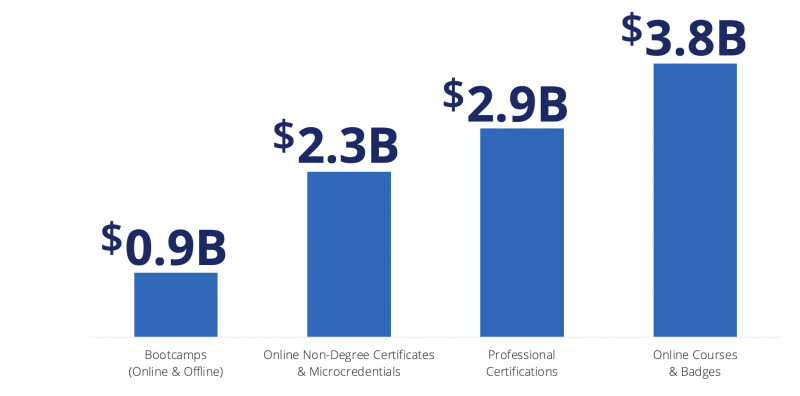A 2020 survey, conducted by UPCEA, found that 70% of academic institutions have a portfolio of alternative credentials and the rest are considering the development of such programs. Though these types of credentials are not new, they’ve been increasing in popularity in the wake of COVID’s forced online migration, along with a re-focus of energy on upskilling and reskilling for jobs in the future.
Going to market in the right way has become a challenge. When institutions enter the alternative credential space, they shake off the constructs of the degree and enter a much larger marketplace, especially given the rapid growth of alternative credential options. Whether you’re expanding an existing portfolio or making plans to launch a new one, here are three steps to build a successful alternative credentials portfolio.
1. Evaluate your alternative credential portfolio
While there are many unknowns about the alternative credential market, the breadth of providers in the space can’t be mistaken. From colleges and universities to corporations to individual training providers, it seems everyone is getting involved.
Research from HolonIQ found that spend in the alternative credential space was nearly $10 billion in 2019 and is growing rapidly—with projections that it will double in the next 3–5 years. With this expansion comes a similar growth in the types of programs offered, such as bootcamps that directly support tech jobs upon completion and short courses that support upskilling in areas like project management. These alternative credentials are supporting the growing needs of businesses and job seekers alike.
What does this mean for higher ed institutions looking to grow their own portfolios? First, it means evaluating job demand in your local market to identify current skills gaps from employers, as well as understanding trends for skills that will be in demand in the future. It also means ensuring you’re teaching skills that will allow students to advance in their careers.
Finally, when you’re considering entering such a crowded space, it’s important to consider what differentiates you as an institution. How can you leverage your brand and areas of academic expertise to provide a halo around your alternative credential offerings?
Estimated Market Size for Alternative Credentials¹

2. Consider learning design best practices to build courses that meet student demand
Alternative credentials meet many prospective students’ academic goals by providing them with specific knowledge over a short period of time, especially relative to a degree program. The aforementioned UPCEA survey also found that many schools see alternative credential offerings as a way of serving a population that is altogether different then the degree seeking student. This helps allay fears that developing such programs may lead to “cannibalization” of degree programs.
Before the COVID-19 pandemic, approximately 73% of alternative credentials were taught online, according to the UPCEA survey, allowing busy working professionals to enhance their skill sets in a way that was convenient for them. That number is now close to 100%, and will likely net out somewhere in the middle.
How does this impact colleges and universities looking to provide alternative credentials? With the shift to online, it is important to utilize instructional design best practices to develop high-quality, interactive programs.
Going online doesn’t mean simply posting videos of in-class lectures and calling it a day. Successful online education—whether in short courses or full-length degree programs—is thoughtful about building dynamic and engaging learning experiences. It ensures students can practice skills in a way that can be evaluated, which is especially important in the alternative credential space as students work to level up their skills for a specific job.
3. Connect with alumni and the community
Online courses can be taken anywhere, and yet, many students prefer to enroll in courses offered by institutions that are nearby. One longitudinal study of adult learners found that the proportion of students that enroll in online courses increasingly choose to do so at schools with a physical campus within 50 miles from their home.
In your local community and among your alumni, alternative credentials offer a great way to build sustained relationships with some of your strongest constituents. Expanding your programmatic offerings will ensure that you meet the needs of alumni across their careers. These groups’ affinity for your institution will have them look to you first for these programs, but they will search elsewhere for faster, less-expensive alternatives to degrees if they can’t find what they need. By understanding the needs of your lifelong learning community and adding alternative credentials to your portfolio of programs, you can continue to engage learners throughout their lives and careers.
Fostering this sense of community also provides an important channel for advocacy and awareness for your alternative credentials. Alumni can serve as an important resource to share details of your programs and to provide a sounding board for your future offerings. Similarly, the community you support locally can provide critical insights into not only the content of your courses, but also how to market them.
Starting your alternative credential journey or expanding your footprint?
The alternative credential market is growing, and many prospective students are looking for non-degree alternatives. This provides colleges and universities a significant opportunity to expand their programming and reach more students. Choosing the right types of courses to offer, designing high-quality learning experiences and tapping into alumni networks and local communities are important steps in building a successful alternative credential portfolio.
Once you get to that point, however, your work is not done. The flexibility that alternative credentials offer should extend beyond the actual course offering to the student experience in searching for and registering in a course. Evaluating your marketing and enrollment services, and even the eCommerce platforms to facilitate payment, can help to smooth the process for incoming students.

